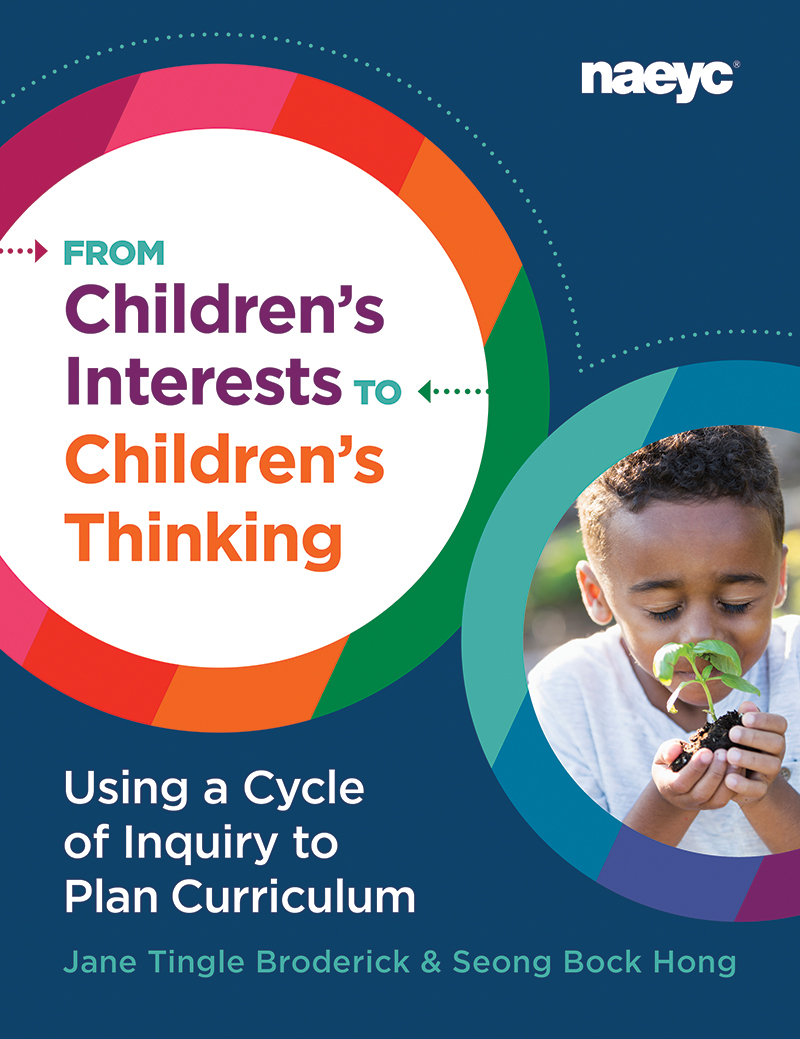Threads of inquiry are the pathways for learning that children follow with the careful facilitation of intentional teachers. They come from both the ideas of children and the musings and observations of teachers. These facets of interest and learning center on Big Ideas, which are content-focused concepts (McLean, Jones, & Schaper 2015) that weave together diverse threads of inquiry. Using threads of inquiry successfully can be a strategy to extend emergent inquiry curricula through an entire year and beyond in one classroom.
Teachers using an emergent inquiry curriculum are responsive to children, planning provocations around questions they have developed that challenge the children toward the edges of their own understandings. Teachers identify emerging threads of inquiry during the process of reflecting on their documentation of children’s play.
The best indicators of an emerging thread of inquiry are the problems children face during play, the questions they ask, the things they wonder about, and what happens in the moments they show spontaneous curiosity (Forman & Hall 2005). With all the activity in a day’s work with children, these key indicators are easily lost if they are not documented by observant teachers (see Chapter 4 of Children’s Interests to Children’s Thinking for more about the documentation process).
For example, when children in a bluegrass study plucked and strummed the strings of the bluegrass instruments (banjo, guitar, mandolin, fiddle), teachers noted their interest and puzzlement. They observed the children’s surprise when they expected the high sound to be on the top string of an instrument and it wasn’t. This little bit of a problem led teachers to plan many experiences for studying and discriminating the relationships of high and low sounds with the different bluegrass instruments.
If you find yourself, in your planning, pursuing an idea that is becoming clearer or is tying more content together, you are probably pursuing a thread of inquiry—a pathway for learning.
If you find yourself, in your planning, pursuing an idea that is becoming clearer or is tying more content together, you are probably pursuing a thread of inquiry—a pathway for learning. For example, as children began to use the term band during the processes of exploring the individual bluegrass and old-time instruments and then referenced themselves as a band during pretend play episodes, teachers realized that the children’s ideas went beyond the focus of individual instruments to ideas about groups of instruments and performers. Teachers recognized an emerging thread of inquiry—“What is a band?”—that they could plan around to help children answer this question.
Each thread creates depth and draws both children and teachers into deep pursuit of a problem. Threads are situations in which children want to master skills and challenge their theories. For example, the pursuit of the thread “What is a band?” led children to pretend to form bands and perform with mock instruments, to create scenarios with bands using small figures of band members in a small block area, and to create stages and places for bands to go. They used an extended construction of a city in the block area to explore a new thread of inquiry, “Where do we find bands?” This construction interwove exploration of buildings and structures with the bluegrass study. As a result of these varied experiences, children formalized their thinking to better articulate their ideas about bands. They could specifically state that a typical bluegrass band has five instruments: banjo, fiddle, mandolin, bass, and dobro. They demonstrated developing knowledge of space concepts related to the distances between cities and the size and proportion of stages in relation to cars and roads.
Emergent curriculum is not a go-with-the-flow process. Teachers carefully design provocations (discussed in Chapter 3 of Children’s Interests to Children’s Thinking) that keep the thinking close to the children’s current pursuits, while holding the direction of the inquiry close to the children’s initial interests, questions, and developing theories. For example, as children listened closely to the words of bluegrass songs and drew their interpretations, there were instances when they diverged from the focus on the songs to draw and talk about rainbows or butterflies. The teachers did not view these conversations as new project opportunities to study rainbows or butterflies. Instead, they paid attention and recognized that overall the children remained deeply engaged in the process of drawing and interpreting the words of the songs. By keeping track of the events of each experience related to the bluegrass study, the teachers’ documentation became a critical tool for reflection and planning (Broderick & Hong 2011; Hong 1998). They designed provocations that followed the emerging and spontaneous questions and curiosities of children, intentionally holding the curricular content together within the focus on the bluegrass study.
 As this excerpt demonstrates, emergent curriculum is an engaging, effective way for young children to learn and an enjoyable way for educators to teach. NAEYC’s newest book on the subject, From Children’s Interests to Children’s Thinking: Using a Cycle of Inquiry to Plan Curriculum by Jane Tingle Broderick and Seong Bock Hong, is filled with practical guidance from observation through documentation to demonstrating how to make children’s learning visible.
As this excerpt demonstrates, emergent curriculum is an engaging, effective way for young children to learn and an enjoyable way for educators to teach. NAEYC’s newest book on the subject, From Children’s Interests to Children’s Thinking: Using a Cycle of Inquiry to Plan Curriculum by Jane Tingle Broderick and Seong Bock Hong, is filled with practical guidance from observation through documentation to demonstrating how to make children’s learning visible.
Broderick, J.T., & S.B. Hong. 2011. “Introducing the Cycle of Inquiry System: A Reflective Inquiry Practice for Early Childhood Teacher Development.” Early Childhood Research and Practice 13 (2).
Forman, G., & H. Hall. 2005. “Wondering with Children: The Importance of Observation in Early Education.” Early Childhood Research and Practice 7 (2).
Hong, S. 1998. “Documentation-Panel-Making and Revisiting Using Technology to Enhance Observation and Instruction Skills in Student Teachers.” Doctoral diss., University of Massachusetts Amherst (UMI No. 9841879).
McLean, K., M. Jones, & C. Schaper. 2015. “Children’s Literature as an Invitation to Science Inquiry in Early Childhood Education.” Australasian Journal of Early Childhood 40 (4): 49–56.
Jane Tingle Broderick, EdD, is a professor of Early Childhood Education at East Tennessee State University, where she co-coordinates the Early Childhood PhD Program and the Early Childhood Education Emergent Inquiry Certificate Program. She has taught in early childhood for more than 20 years.

Seong Bock Hong, EdD, is a professor of Early Childhood Education at the University of Michigan–Dearborn, where she teaches graduate and undergraduate early childhood courses. She was the faculty director of the Early Childhood Education Center, a university lab school, from 2012 to 2017. She served as an interim director and documentarian at the Reggio-inspired Early Childhood Laboratory School during her doctoral studies at UMass, Amherst.

